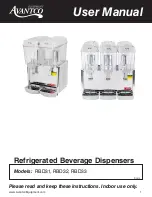
PAGE 4
PRE-INSTALLATION REVIEW
WATER QUALITY:
If sand or sediment is present in the water supply, a sediment filter should be installed ahead of the water softener.
Your water softener has been designed to adequately reduce hardness from levels up to 100 grains per gallon. Ferrous bicarbonate iron
levels up to 0.5 ppm can also be reduced. This is iron that is dissolved in water and not visible to the eye in a freshly drawn sample. After
standing in contact with air, the ferrous iron will become oxidized to the ferric state and start to precipitate as a reddish brown floc. It can
be seen and may cause discolored water. Air must not come in contact with water until after it has passed through the water softener. In
some cases, additional treatment equipment may be needed to treat water having special characteristics, such as: ferric hydroxide iron,
iron bacteria, low pH, tastes and odors, etc. Consult your dealer if you have any questions.
This water softener is not to be used for
treating water that is microbiologically unsafe or of unknown quality without adequate disinfection before or after treatment.
WATER PRESSURE:
A minimum of 20 pounds of water pressure (psi) is required for regeneration. Maximum 100 psi. CAUTION: the
softener cannot be subject to a vacuum due to loss of pressure (such as a water main break or submersible well pump check valve failure).
WATER TEMPERATURE:
The range of water temperature is 40°F to 100°F. DO NOT install any water softener with less than 10 feet of
piping between its outlet and the inlet of a water heater.
AMBIENT TEMPERATURE:
DO NOT locate softener where it or its connections (including the drain and overflow lines) will ever be
subject to room temperatures under 33°F.
ELECTRICITY:
An uninterrupted 120 volt 60Hz source is required.
Make sure electrical source is not on a timer or switch.
All electrical
connections must be connected according to local codes. The plug-in transformer is for dry locations only. Surge protection is recommended
with all electrical connections.
DRAIN:
All plumbing should be done in accordance with local plumbing codes. The distance between the drain and the water softener
should be as short as possible. The pipe size for the drain line should be a minimum of 1/2” (inside diameter of pipe).
SOFTENING:
It is recommended that the softener be installed to soften both the hot and cold water supply. A separate hard water faucet
may be plumbed for drinking purposes if desired. Outside faucets should be left on hard water.
BYPASS:
A bypass valve should be installed so that water will be available if it should be necessary to shut off the pressure in order to
service the softener.





































